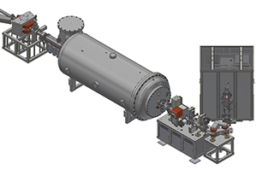An atomic-force microscope image of a layer of single-walled carbon nanotubes deposited on a silicon surface, as the first step in manufacturing the new type of solar cell developed by an MIT team. Individual nanotubes can be seen in the image. Image: Rishabh Jain et al |
About 40% of the solar
energy reaching Earth’s surface lies in the near-infrared region of the
spectrum—energy that conventional silicon-based solar cells are unable to
harness. But a new kind of all-carbon solar cell developed by Massachusetts
Institute of Technology (MIT) researchers could tap into that unused energy,
opening up the possibility of combination solar cells—incorporating both
traditional silicon-based cells and the new all-carbon cells—that could make
use of almost the entire range of sunlight’s energy.
“It’s a fundamentally
new kind of photovoltaic cell,” says Michael Strano, the Charles and Hilda
Roddey Professor of Chemical Engineering at MIT and senior author of a paper
describing the new device in Advanced Materials.
The new cell is made
of two exotic forms of carbon: carbon nanotubes and C60, otherwise known as
buckyballs. “This is the first all-carbon photovoltaic cell,” Strano says—a
feat made possible by new developments in the large-scale production of
purified carbon nanotubes. “It has only been within the last few years or so
that it has been possible to hand someone a vial of just one type of carbon
nanotube,” he says. In order for the new solar cells to work, the nanotubes
have to be very pure, and of a uniform type: single-walled, and all of just one
of nanotubes’ two possible symmetrical configurations.
Other groups have made
photovoltaic (PV) cells using carbon nanotubes, but only by using a layer of
polymer to hold the nanotubes in position and collect the electrons knocked
loose when they absorb sunlight. But that combination adds extra steps to the
production process, and requires extra coatings to prevent degradation with
exposure to air. The new all-carbon PV cell appears to be stable in air, Strano
says.
The carbon-based cell
is most effective at capturing sunlight in the near-infrared region. Because
the material is transparent to visible light, such cells could be overlaid on
conventional solar cells, creating a tandem device that could harness most of
the energy of sunlight. The carbon cells will need refining, Strano and his
colleagues say: So far, the early proof-of-concept devices have an
energy-conversion efficiency of only about 0.1%.
But while the system
requires further research and fine-tuning, “we are very much on the path to
making very high efficiency near-infrared solar cells,” says Rishabh Jain, a
graduate student who was lead author of the paper.
Because the new system
uses layers of nanoscale materials, producing the cells would require
relatively small amounts of highly purified carbon, and the resulting cells
would be very lightweight, the team says. “One of the really nice things about
carbon nanotubes is that their light absorption is very high, so you don’t need
a lot of material to absorb a lot of light,” Jain says.
Typically, when a new
solar cell material is studied, there are large inefficiencies, which
researchers gradually find ways to reduce. In this case, postdoctoral
researcher and co-author Kevin Tvrdy says, some of these sources of
inefficiency have already been identified and addressed: For instance,
scientists already know that heterogeneous mixtures of carbon nanotubes are
much less efficient than homogeneous formulations, and material that contains a
mix of single-walled and multiwalled nanotubes are so much less efficient that
sometimes they don’t work at all, he says.
“It’s pretty clear to
us the kinds of things that need to happen to increase the efficiency,” Jain
says. One area the MIT researchers are now exploring is more precise control
over the exact shape and thickness of the layers of material they produce, he
says.
The team hopes that
other researchers will join the search for ways to improve their system, Jain
says. “It’s very much a model system,” he says, “and other groups will help to
increase the efficiency.”
But Strano points out
that since the near-infrared part of the solar spectrum is currently entirely
unused by typical solar cells, even a low-efficiency cell that works in that
region could be worthwhile as long as its cost is low. “If you could harness
even a portion of the near-infrared spectrum, it adds value,” he says.
Strano adds that one
of the paper’s anonymous peer reviewers commented that the achievement of an
infrared-absorbing carbon-based photovoltaic cell without polymer layers is the
realization of “a dream for the field.”





